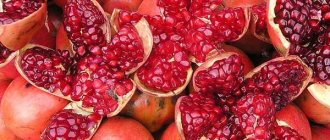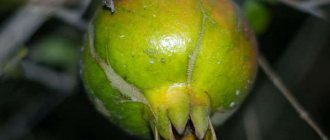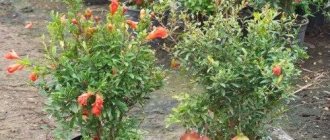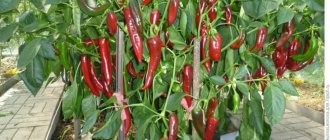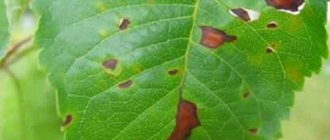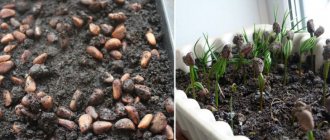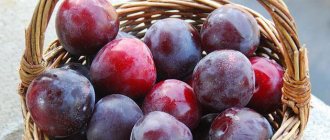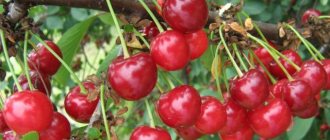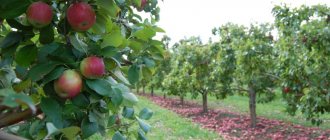History of the name of the fruit
Pomegranate is a wonderful plant. The history of its name is interesting. This plant was known back in the times of the Ancient World. At that time it was believed that the best trees grew in Carthage. The Romans called the fruit malum punicum, which translated means “Punic apple.” The thing is that in the tenth century BC the Phoenicians moved from their native land to Africa, founding new settlements there, including the famous Carthage. And for the Romans, the Phoenicians themselves are Punics, hence the name – Punic apple.
But the pomegranate also had a second name - malum granatum, which means “grainy apple”. It was this that later became very widespread. But the botanical name Punica was given to the plant in 1758 by Carl Linnaeus.
Origin
Pomegranate has been known to mankind for more than four thousand years; Italians are sure that it was Eve who offered it to Adam in the Garden of Eden; some languages contain the word apple in the names of this fruit. At all times, people not only enjoyed the luxurious taste of its berries, but also were treated with all parts of the plant, this can be seen by reading the treatises of Avicenna. This crop grows in a subtropical climate, which means it comes to us from Western Asia, Azerbaijan, Armenia, Georgia, Turkey, and Afghanistan.
Fruits can be stored for a long time at a temperature of +2 degrees and a humidity of at least 85%. They ripen from mid-September, and then they are transported to all continents. The closer the path, the greater the confidence that they were picked ripe, so we need to choose those fruits that are ripe closest to us. Before you buy expensive and so healthy fruits, it is advisable to inquire about their origin - there is a difference between the time and conditions of delivery from Turkey or Turkmenistan.
pomegranate tree
There are different varieties of pomegranates in the world. The plant's homeland is Persia (the territory of modern Iran). Pomegranates grow in the wild and in the Transcaucasus, Central Asia, India, Asia Minor and Afghanistan. In these countries, under favorable conditions, trees can reach five meters in height, but the plant can also be a bush. At the end of the eighteenth century, thanks to the Spanish conquistadors, the crop began to be grown on the American continent.
Pomegranates bloom very profusely from May to August. The plant's large red-orange flowers resemble a bell. They are so beautiful that many people grow the tree just for the sake of flowering. The fruits are spherical in shape and covered with red-brown or yellow-red skin. A pomegranate can weigh up to 600 grams. Inside it there are many seeds surrounded by juicy pulp. It is this that is edible and makes up only 50 percent of the mass of the entire fruit. Each pomegranate contains from 200 to 1400 seeds, located between white partitions. The fruits ripen from September to February in the northern hemisphere, and from March to May in the southern hemisphere. From one tree you can collect up to 60 kilograms of fruit.
The plant itself looks very decorative. In warm climates, ripe fruits crack, hanging directly on the branches. The peel bursts, but the grains are inside and do not crumble. It's just an amazing sight. In temperate climates, the leaves sometimes fall off before the harvest begins. Fruits located on bare branches give the plant an exotic appearance.
General description of pomegranate
Pomegranate is classified as a shrub and tree. The height of plants can reach 2-6 m. The shoots of most varieties are thin, flexible, and colored light brown. The leaves are covered with a waxy coating, oblong in shape, uneven in size (2-8 cm). The leaf blades are attached to the branches using long petioles. The trunk is rough, coarsened, the bark is strewn with small thorns.
Fruit bushes bloom for a long time, starting in May. The flowers are very beautiful, the color is light red with an orange tint. The plant is propagated by cuttings, seeds and layering. Pomegranates are grown not only for food, but also as a decorative element; the photo shows how beautiful the trees look in the garden.
Interesting fact!
Pomegranate, in Eastern countries, is considered a symbol of friendship and fertility. It is used as an element of various rituals on significant family holidays (weddings, christenings, national holidays).
Types of pomegranates
Currently, only two types of culture are known. The common pomegranate grows wild in Asia and southern Europe. The second species grows on the island of Socotra, which is located in the Arabian Sea. Hence its name - Socotran pomegranate. But its taste is significantly lower than that of the common pomegranate, and therefore the plant is not cultivated. In addition, recently a dwarf form of the plant has appeared, which is grown as an ornamental crop on windowsills.
Different varieties of pomegranates, and there are more than 500 of them (cultivated varieties), have different taste qualities, differ in the shape and size of the fruit, the color of the pulp, the color of the juice, the softness or hardness of the seeds. The number of different varieties is increasing thanks to the constant work of breeders, whose main task is to create a plant that will be resistant to all diseases. In Turkmenistan there is the Kara-Kala nature reserve. The largest collection of pomegranates in the world is collected on its territory. There are more than 800 forms, types, and varieties of pomegranate.
Varieties of pomegranate
There are about 500 varieties of guarantor. Breeders are developing new varieties every year. The main emphasis is on breeding a variety that will be resistant to most diseases. Pomegranate is grown in Crimea, Iran and the Mediterranean. In the wild, the fruit grows on the slopes of pine and oak forests.
On a note! In Crimea, there are about 340 species in the botanical garden. These are varieties of both foreign and domestic selection. There are about 800 different forms and species in the reserve of Turkmenistan.
Pomegranate varieties are divided depending on:
- forms;
- type;
- coloring.
The grains also come in different colors and sizes. The main difference is the type of shrub and the region of origin.
Almost all varieties have beautiful double or simple flowers. The bark of the plant is usually brown. The shoots are crooked and quite short. The leaves have an elongated shape. The color is light green. Surface:
- leathery;
- with a little gloss.
The underside of the leaf is matte and has a vein in the middle. The leaves have petioles resembling an ellipse shape. The most common form is:
- lanceolate;
- oblong.
The leaves can reach a length of about 10 cm and a width of 2-3 cm. The plant blooms from May to August.
Pomegranate is divided into 2 main types:
- ordinary;
- Socotran.
Ordinary
The tree grows in the subtropics. It can bear fruit for about 50 years. About 60 kg of harvest is usually harvested from a tree. The height of the bush reaches 6 meters. The branches are quite thin and have thorns. The size of the fruit is similar to an orange. Color varies from yellow to dark red. The growing season reaches 8 months. Fruit ripening occurs on day 150.
Note!
The grains contain citric, malic and oxalic acids, vitamin C and sugar. The peel contains tannins, carbohydrates and steroids.
But there are also side effects. You should not eat pomegranate if you have the following diseases:
- Gastrointestinal tract;
- ulcers;
- erosions.
Persons with allergic reactions should consume the fruit taking precautions. The flower has a funnel shape and a large number of stamens. The flowers are painted in various shades. Pomegranate fruits have thick skin and are shaped like a ball. The weight of one fruit reaches 600-800 grams. Inside the fruit is divided by partitions in which the grains are located. Grains contain seeds. Their color varies from white to dark ruby.
The taste is sweet and sour, the flesh is fleshy and juicy. One fruit can contain up to 1000 seeds. The tree grows in Turkmenistan, Tajikistan and the Caucasus.
Soqotran
It grows mainly on the island of Socotra. Rarely found in the wild. The tree is evergreen. The height reaches 4 meters. The leaves have an oblong shape. The inflorescences are colored pink. The fruits contain a small amount of sugar. Likes to grow on sandy soils. It can grow 300 meters above sea level. Not subject to cultivation.
Depending on the variety, the fruits can be distinguished by their appearance. The peel is:
- scarlet;
- burgundy;
- yellow;
- orange.
The pulp can be white, pink, or crimson. Varieties of this species have a sweeter taste. The taste characteristics of pomegranate are affected by the presence of sucrose and various acids. All varieties of pomegranate can be divided into:
- sweet (sugar content about 18%);
- sweet and sour (sugar content about 10%);
- sour (sugar content no more than 8%).
The taste qualities are most often influenced by the area of growth, climate, and stages of fruit ripeness. Pomegranate requires sufficient heat and light to grow.
On a note!
The most optimal growing area is considered to be the area near the Talysh Mountains.
Main features of sweet fruits:
- the presence of a dark burgundy color in the peel;
- no damage to the skin;
- sufficient fetal weight (at least 150 g);
- woodiness of the stalk;
- no unpleasant odor.
The sweetest varieties:
- Dholka grows in India. The grains are predominantly dark in color.
- Ahmar, grows in Iran, pinkish-red grains
- Nar-shirin, grows in Iran, the grains can be light or crimson in color.
Yellow pomegranates have a sweet taste and virtually no acidity. The grains are colored light pink. When purchasing a yellow pomegranate, you need to make sure that the peel is intact. It should not have dents or damage.
Varieties of pomegranates
We have already mentioned that there are many varieties of pomegranates. All of them are grown for specific purposes. Some are for fresh consumption, others are for processing and juice production. One type of pomegranate makes an excellent and healthy drink, rich in vitamins and microelements. There are also varieties grown for technical processing. In our article we want to present the best varieties of pomegranates and their characteristics. The species grown can be roughly divided into the following groups to show only a small part of the varieties available:
- Sweet Iranian varieties - Sharoli, Halva, Aswad, Akhmar.
- Very sweet Indian - Dholka.
- Sweet and sour varieties - Ulfa, Kyzym, Kok, Wellis.
- Sweet - Lodzhuar, Kadan, Vedana, Nar Shirin.
- American seedless variety (soft seeds) - Wonderful.
- Israeli varieties - Ras el Bahl, Malissi, Red Loufani, Mangulati.
- Indian - Alandi, Bedana.
- Crimean and Transcaucasian varieties that ripen in October are Veles, Kaim nar, Krmyzy kabukh, Shah-par, Bala-mursal, Galyusha pink, Galyusha red.
- Sweet and sour Central Asian varieties - Kzyl-anar, Achik-Dona, Kazake-anar.
- Tart sour variety – Achikanor.
- Early sweet varieties ripening in September - Ulfi, Lodzhuar, Ak-Dona.
- Japanese dwarf variety bred for growing in pots (has numerous small fruits) - Punica granatum var.
- Decorative varieties - Multiplex, Variegata, Chico.
Pomegranate
Product Description
Pomegranate is a fruit the size of an apple or orange, covered with a thick dark red crust. Inside the fruit there are many grains with juicy bright burgundy pulp and a small seed inside.
Pomegranate the Mediterranean and the Middle East. Pomegranate trees bear fruit for many years and live up to about 100 years.
Pomegranate is a complete vitamin and mineral complex . Pomegranate juice contains amino acids that are found only in meat and are essential for the human body (so if you are a vegetarian and eat exclusively plant and dairy foods, then pomegranate should always be on your table). It also contains 4 main vitamins: C, P, B6 and B12: vitamin C strengthens the immune system, P - blood vessels, B6 - the nervous system, and vitamin B12 improves blood formation. In addition, pomegranates are simply ideal for fasting days, since 100 g of pulp contains 62-79 kcal, and 100 ml of pomegranate juice contains 42-65 kcal. Pomegranates are also rich in minerals such as iodine, potassium, calcium, iron, and silicon.
This miracle fruit has a disinfectant effect due to the tannins it contains. Most of these substances are not in the pulp, but in the bark: it can be used for infectious diseases as a herbal antiseptic. Pomegranate juice improves appetite and normalizes the functioning of the gastrointestinal tract. A decoction of its peel will even help get rid of intestinal dysbiosis.
Regular consumption of pomegranates is believed to reduce the risk of breast cancer in women. It is also very useful for various heart diseases. Fresh fruits are effective for coughs, colds and malaria; they are prescribed as a general tonic for exhaustion, anemia and atherosclerosis. In addition, pomegranate has a positive effect on vision: the anthocyanins it contains promote the synthesis of the light-sensitive pigment rhodopsin, which significantly improves the eyes' adaptation to darkness.
Types and varieties
Pomegranate varieties differ in fruit size, grain hardness/softness, degree of sweetness and ripening time. Here are just a few of them.
Dogwood anor is an early ripening variety and can usually be harvested in early October. These pomegranates are grown in Uzbekistan. The fruits are round-flat in shape, come in both small and large sizes, the skin is thin, the grains are medium-sized, dark red in color.
Ak Dona , also known as Tyuyatish (that is, camel tooth) - the variety was bred in Central Asia. The fruits are round-flat in shape, the peel is light with a pleasant raspberry tint, the grains are large, elongated, pink in color, the calyx has a cone-shaped shape with curved edges.
Achik-anor is a sweet and sour variety of pomegranate, its fruits are round in shape, slightly narrowed at the base, the peel is thick, green-carmine in color, the calyx teeth are straight, the grains are large and have a pronounced dark cherry color.
Gyuleysha ( Gyulosha ) pink and red are the best pomegranate varieties growing in Azerbaijan. The fruits of the first representative have a rounded-elongated shape, a thin creamy-pink skin, a cylindrical neck with a narrow cup, medium-sized grains of a dark cherry color. In the second, the fruits reach large sizes, the skin is carmine-red in color with stripes at the base of the fruit, the neck is high and of medium thickness, the edges of the cup are curved or curved, the grains are large and dark cherry in color. Both varieties have a pronounced sweet and sour taste.
Ak Dona Krymskaya is a pomegranate variety with large rounded fruits, has a thin creamy skin with red spots and a one-sided blush, the neck is thick and short, the calyx is large with straight narrow edges, the grains are pinkish-red in color, the taste is sweet with a barely noticeable sourness.
Other varieties include Nar Shirin , Vedana , Kadan , Lodzhuar , Vellis , Kok , Kyzym , Ulfa , Bala-Mursal , Kazake-anor , Shirin-anor , Krmyzy Kabuhi , Shikhbaba and many others.
Wonderful is a “seedless” pomegranate bred in the USA and distributed in America and Southern Europe. The fruits are small, but very sweet, have a white-yellow color with a slight blush, the grains are small and soft.
There are particularly significant places for growing pomegranates - unique pomegranate appellations. For example, the Azerbaijani city of Goychay , where on the days of pomegranate harvesting there is even a special holiday.
How to cook
First you need to clean the pomegranate . The first method: use the tip of a knife to cut out the place of flowering, then cut the peel of the fruit from top to bottom along the “ribs” (they are noticeable, although they do not protrude very much) and break the fruit into slices along the cuts. The second way: cut the fruit in half and, holding the halves over the container, lightly tap the pomegranate peel with a spoon - the grains themselves will fall out onto the plate.
Pomegranates are eaten fresh and used to make jam, pastilles, syrups, drinks, wines, ice cream, and seasonings for various national dishes.
By evaporating the juice from the fruits of sour varieties, one gets narsharab - one of the best seasonings for many Caucasian dishes.
Pomegranate juice is pressed from pomegranates .
Season
In the Northern Hemisphere, pomegranate season lasts from September to January. In the second half of September, early ripening varieties ripen in southern countries (for example, in Egypt). At the beginning of October, pomegranates of early ripening varieties can be collected in Central Asia and Transcaucasia.
In the Southern Hemisphere, pomegranate season runs from March to May.
How to select and store
The pomegranate must be ripe : fruits picked ahead of time at home no longer ripen.
Unfortunately, choosing a ripe pomegranate without opening it is more difficult than many other fruits. There is even an opinion that this process is akin to a lottery - you will be lucky or unlucky. And yet some signs and patterns exist.
In the East they say that pomegranate should be dry on the outside and juicy on the inside. This means that the crust of a ripe fruit is slightly dried out and (attention!) seems to hug the grains. This is important, because the pomegranate can dry out even if it lies for a long time, but then there won’t be this tight-fitting effect, because the grains dry out along with the peel. If the crust is smooth and not dried out, it means that the pomegranate was picked from the tree before it had time to ripen. Its seeds may already be red, but red in this case does not mean “sweet.”
Another important point. Look at the place where the pomegranate had a flower: anything green there.
A quality garnet should be hard to the touch . If it’s soft, it means it was damaged: beaten on the road, frozen or rotted.
Whole fruit can be stored in a cool, dry, well-ventilated place for 1-2 months. Pomegranate seeds can be frozen, but without the peel and films. To do this, the peeled grains need to be placed in a clean bag, tied and placed in the freezer, so they can be stored for a whole year.
Fresh pomegranate juice will keep in the refrigerator for two to three days.
Gyulyusha
It is difficult to select the best varieties of pomegranate, since each person has his own taste, and different types are grown for completely different purposes. For example, sour fruits are cultivated for making sauces, and sweet ones for fresh consumption.
The best Azerbaijani varieties of pomegranate (photos are given in the article) are pink and red Gyulyusha. The pink variety has fruits weighing 220-250 grams, but sometimes there are much more round fruits. The juice yield from them reaches 54%. The grains of this variety are medium in size and have an excellent taste.
Red gulyusha has the shape of a bush (up to three meters in height). The fruits of the plant are quite large - 300-400 grams. They are covered with a pink thin crust. The fruit contains large grains, from which bright red juice with a sweet and sour taste is obtained. The fruit ripens in October and can be stored for two to three months. The variety is also grown in Georgia and Turkmenistan.
Bean color
The color and taste of the beans vary between varieties. The grains are white, pale pink, red, purple. The taste of pomegranate is rich, rich, its pulp contains sugars and acids, the amount of which explains the difference. The astringency and bitterness that remains on the tongue after the juice most often comes from the skin, and the berries themselves are sweet or sweet and sour. By the way, it is precisely because of the very active acids that it is recommended to drink juice through a straw, and after eating the berries you should definitely brush your teeth or at least rinse your mouth with clean water - these same acids (which are very beneficial for the body) destroy tooth enamel.
We are accustomed to the fact that pomegranate seeds should be dark red; these are the ones that look great on the table as a decoration, which is why they are used for salads or desserts. They are usually sour, and the sweetest fruit contains white or pale pink grains. Such grenades have recently been brought to us from Turkey. They contain less acids but more sugars.
Ak Don Crimean
Currently, there are varieties of pomegranate (photos are given in the article) that are cultivated in completely unusual regions. For example, Ak Don Crimean is grown in the steppe Crimea. The fruits are oval in shape and large in size. The variety is easily recognized by its thin creamy peel with reddish spots on one side. The fruit has a thick and short neck. The pink-red grains have a characteristic sweet taste with a barely noticeable sourness. This variety is grown even by amateur gardeners, since it is not too capricious. But to truly enjoy a ripe, delicious fruit, you need to choose the fruit that has been soaked in the southern sun and is fully ripe.
Flower
Each pomegranate contains the remains of the flower. The so-called “crown” can tell us how ripe the fruit is when we pick it up: if all the cloves are dry and break well, and the middle does not contain any remaining greenery, then the fruit was picked ripe. This flower can be of varying degrees of openness, but the main thing is that it does not contain not only greenery, but also no traces of mold.
You can not only turn the fruit, examine it from all sides, look from the side of the flower, you also need to smell it. Properly stored fruit should have no odor. Its own faint, fresh, slightly spicy aroma can only be discerned by breaking (or cutting) the skin. So, if you notice a barely noticeable smell of mold, put the fruit back, it’s better to look at another seller.
Ahmar
It is believed that the most wonderful and delicious pomegranates are grown in Iran. One of the best sweet varieties is Akhmar. The plant grows up to four meters in height and blooms with bright red-orange flowers. The tree blooms from June until the very end of August. The fruits are covered with a thick green-pink skin and are of medium size. The fruit of this variety is characterized by pink light grains. The lighter the kernels, the sweeter they taste. According to experts, the sugar content in Akhmar pomegranate is so high that the variety occupies a leading position in this indicator.
Planting a pomegranate
An important condition for growing pomegranate is the total sum of active temperatures is at least 3,000 and the winter temperature is about 15 °C. It is warmth that is the key to large and good fruits.
Pomegranate is undemanding to soil. Can grow even on wet soils. But you still need to prepare the soil and arrange drainage so that moisture is removed and does not stagnate. Drainage can be crushed stone, expanded clay, or less often gravel. The soil for pomegranate may have an alkaline reaction and a loamy structure, but in this case it needs to be properly charged with organic and mineral fertilizers.
The planting hole is dug in the same way as for many fruit trees (60x70 cm), a fertile layer of soil (about 15 cm) is poured onto the bottom, followed by humus mixed with soil (somewhere a little larger than a bucket). Spread the roots and gently sprinkle with soil.
After planting, water well and mulch the soil with dry weeds, straw or humus. This will help the moisture stay in the soil longer.
If you will cover the pomegranate for the winter, it makes sense to plant the seedling at an angle of 60-45° to the south.
Nar-sharin
Nar-sharin is similar in taste and description to Akhmar. But this variety is characterized by a light skin color even in ripe fruits. On the outside the skin is beige with pink spots, and on the inside it is almost white. Pomegranate seeds are quite small, but very sweet. Their color gradually changes from light pink to very dark. An interesting fact is that Iranian pomegranates grow in the wild, and they began to be cultivated not so long ago and only in the central region. The local population uses fruits picked from wild plantings for food.
How to properly peel a pomegranate?
Now let me get to my least favorite part of dealing with these delicious fruits: peeling them. There are several sure-fire ways to peel a pomegranate without splashing yourself, your children, and the area around you with pomegranate juice.
1 way
I almost always peel pomegranates this way, but I don’t always do it with mathematical precision (humanitarian, whatever you want!), and therefore sometimes I still stain myself and the kitchen with juice.
- find the top of the fruit, that is, the place where its inflorescence used to be;
- cut it with a knife about 1 centimeter deep so that the grains and white veins appear, dividing the fruit into sections;
- and now feel free to “saw” the fruit directly along these lines outlined by nature - that is, divide it into natural sections;
- as a result, you will get slices - from 6 to 12 pieces with intact seeds, which means you will not, like a character in a horror film, be splashed with blood-red liquid.
Method 2
I did this only a couple of times, but for some reason I didn’t like this method - it was too painstaking.
- the top of the pomegranate is also cut 1 centimeter deep;
- the fruit itself is turned over with the cut part down over a deep bowl;
- you pick up a spoon or the handle of a knife and start tapping the peel with the chosen tool;
- you need to do this quite strongly, but without fanaticism (this is not an attraction for measuring strength), otherwise you are guaranteed bloody stains in the kitchen;
- if you knock on the pomegranate correctly, then you will not have to hit the same place twice, and the grains themselves will fall not at your feet, but into your previously prepared container;
- professionals who are experienced in pomegranate cleaning claim that literally five minutes are enough to extract all the sweet grains.
3 way
Craftsmen suggest peeling pomegranates under water. No, this is not a method for ichthyanders. Rather, it is suitable for cleanrooms.
- the fruit cut using the first method can be immersed in water for a while;
- when it lies there, the white husk separating the sections from each other will swell, and you can easily get rid of it;
- do it right under water - well, don’t dive, of course, but just put your hands down and grab the pomegranate, then your fingers will remain clean, and you won’t have to clean the kitchen.
4 way
This is also for water lovers and those people who always don’t have enough time for anything or, as in this particular case, there is no time for long-term cleaning of a pomegranate.
- place the fruit in clean water at room temperature for about half an hour;
- after the specified time, cut off its top so that the grains become visible;
- Unfold the cut sections of the fruit slightly;
- prepare a large bowl - preferably one that occupies the entire volume of the sink;
- Place your pomegranate under a powerful stream of running water and get ready to watch as it washes the grains directly into your pre-set container.
Here are some simple ways to clean a pomegranate. Although, as far as I know, usually these fruits are cut into four slices and the grains begin to be scooped out of them, the juice of the damaged pulp splashes out in all directions - it’s a thriller, and it’s also time-consuming.
